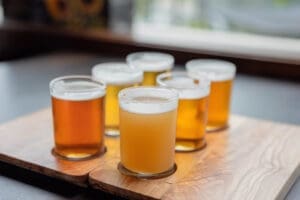Beer has been a beloved beverage for centuries, and its varieties are numerous and diverse. Among the many types of beer, pilsners, lagers, and IPAs (India Pale Ales) stand out as some of the most popular and distinctive. If you’ve seen these on the tap list and wondered what the difference between each is, we’re here to help you out! Understanding the differences between these three types can enhance your appreciation for beer and guide them in selecting the right brew for their palate.
 Lagers
Lagers
Lagers, including pilsners, represent one of the two main categories of beer, the other being ales. The primary difference between lagers and ales lies in the type of yeast used for fermentation and the temperature at which fermentation occurs. Lagers use bottom-fermenting yeast (Saccharomyces pastorianus) and are fermented at cooler temperatures, typically between 45-55°F (7-13°C). This cooler fermentation process results in a slower and more extended fermentation period, producing clean, crisp, and smooth beers. Common lager styles include not only pilsners but also bocks, dunkels, and Märzens.
Pilsners
Pilsners, a subset of lagers, originated in the Czech city of Plzeň (Pilsen) in the mid-19th century. They are distinguished by their pale golden color, bright clarity, and pronounced hop bitterness. Traditional Czech pilsners, like the renowned Pilsner Urquell, often feature a malt sweetness balanced by the spicy, floral aroma and flavor of Saaz hops. German pilsners, on the other hand, tend to be lighter in body and color, with a more pronounced bitterness and a slightly drier finish. Both styles of pilsners share the hallmark characteristics of being refreshing, with a moderate alcohol content usually ranging between 4-5.5%.
IPAs
IPAs, or India Pale Ales, belong to the ale category and are characterized by their use of top-fermenting yeast (Saccharomyces cerevisiae) and warmer fermentation temperatures, typically between 60-72°F (15-22°C). This warmer fermentation process results in a quicker and more vigorous fermentation, producing beers with complex, fruity, and sometimes spicy flavors. The history of IPAs dates back to the late 18th century when British brewers created a hoppier, higher-alcohol version of pale ale to survive the long sea voyage to India. The high hop content acted as a natural preservative, ensuring the beer remained fresh. Modern IPAs are renowned for their bold hop flavors and aromas, ranging from citrusy and piney to fruity and tropical, depending on the hop varieties used. American IPAs often emphasize these hop characteristics, with some sub-styles, like West Coast IPAs, featuring a dry finish and strong bitterness, while New England IPAs are known for their hazy appearance, juicy flavor, and softer bitterness. The alcohol content of IPAs typically ranges from 5.5% to 7.5%, though double or imperial IPAs can exceed 8%.
Flavor Profiles
One of the key distinctions between pilsners, lagers, and IPAs is their flavor profiles. Pilsners and lagers, in general, tend to be lighter in body and color, with a focus on malt and hop balance that results in a clean, crisp taste. The bitterness in pilsners is noticeable but balanced by the malt sweetness, making them highly refreshing and easy to drink. In contrast, IPAs are dominated by hop flavors and aromas, often exhibiting a pronounced bitterness that can be quite intense. The malt profile in IPAs serves to support and balance the hops but is usually less prominent than in lagers and pilsners.
Brewing Process
The brewing process also highlights differences among these beers. Lagers, including pilsners, undergo a longer, cooler fermentation and maturation period, which contributes to their smooth, clean taste. This process, known as lagering, can take several weeks to months. IPAs, with their warmer fermentation and shorter production time, retain more of the yeast’s fruity and spicy characteristics, resulting in a more complex flavor profile.
Food Pairings
When it comes to pairing with food, the differences between pilsners, lagers, and IPAs become evident. The light, crisp nature of pilsners makes them excellent companions for a wide range of dishes, including salads, seafood, and light appetizers. Their refreshing qualities can also complement spicy foods by tempering the heat. With their clean and balanced profile, Lagers are versatile and can pair well with dishes like grilled meats, sausages, and fried foods. IPAs, with their bold hop flavors and bitterness, are best paired with rich, flavorful foods that can stand up to their intensity. They work particularly well with spicy cuisines, such as Indian or Mexican, as well as hearty dishes like burgers and steaks.
Try a Variety of Styles of Beer at The Growler Guys
While pilsners, lagers, and IPAs are all popular types of beer, they differ significantly in their brewing processes, yeast types, fermentation temperatures, and flavor profiles. Lagers and pilsners are characterized by their clean, crisp taste and balanced malt and hop profiles, resulting from cooler, longer fermentation processes. IPAs, on the other hand, offer bold, complex hop flavors and aromas derived from warmer, shorter fermentation periods. Understanding these differences can enhance one’s appreciation for the diverse world of beer and assist in selecting the right brew for any occasion. When you visit The Growler Guys, you can easily learn more about beer styles and discover new favorites. Each location features an extensive tap list highlighting extraordinary local craft beers. See our tap lists online and visit us in person today!

 Lagers
Lagers
Reader Interactions